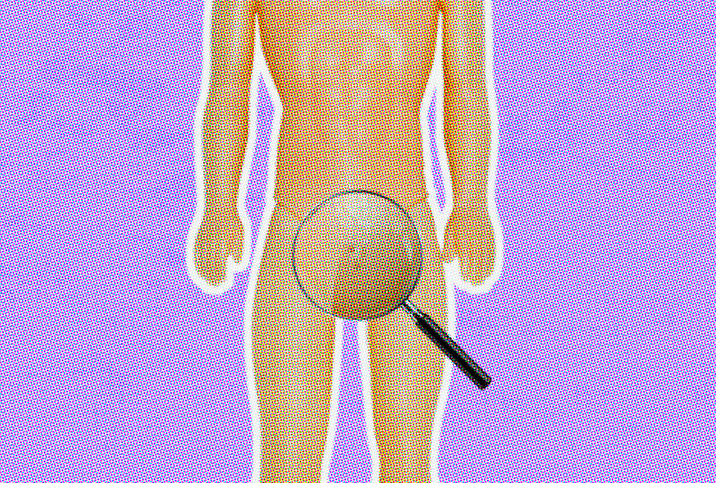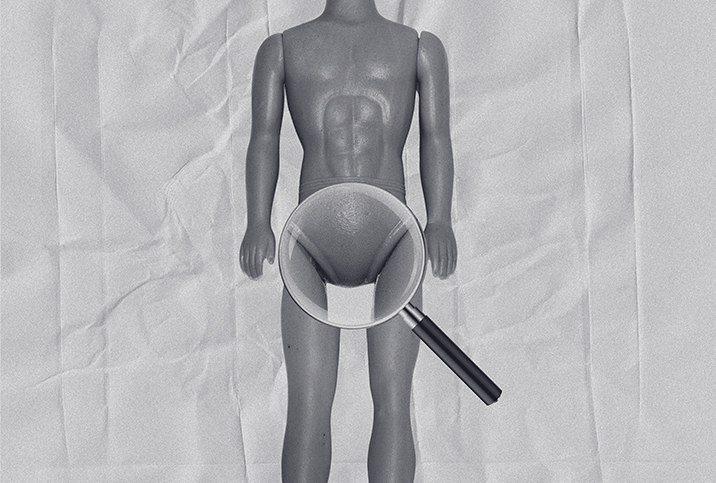Buried Penis and How It Is Surgically Repaired

Some people, even if they have a normal-size penis, can't see it. Their vision is fine. Their penis is where it is supposed to be. But it is out of sight. It is hidden under the skin of the abdomen or the scrotum.
They have a condition known as buried penis.
Medical experts recognize two distinct types of buried penis. One is seen in infants and young children, and the other happens to adults.
With infants and young children, buried penis is commonly associated with a circumcision that takes too much or not enough skin, leaving the penis with an appearance of being surrounded by skin.
In adults, buried penis can sometimes be found in men who've had too much skin removed during circumcision. More commonly, though, it's the result of obesity that has caused the flesh around the groin to grow so fatty and distended that it essentially engulfs the penis, resulting in numerous complications:
- Urine sprays onto the groin and thighs, which often causes men to need to sit to urinate.
- The skin and fat encapsulate the penis, causing urine to become trapped inside.
- Yeast overgrows in such a moist, dark area and causes frequent infections and constant irritation.
- Irritation, over time, results in scar tissue building up on the penis and surrounding tissue.
- Achieving erections is difficult and/or painful.
- Penetrative sex is difficult.
Diabetes is often a comorbidity of obesity, and the subsequent nerve damage can exacerbate the irritation and swelling that leads to buried penis.
While surgically addressing buried penis is complicated, surgeons who see patients suffering from it are quick to point out that living with buried penis is sometimes a pretty grim experience.
"It can be incredibly challenging," said Amy Pearlman, M.D., a urologist and the director of men's health at the Carver College of Medicine at University of Iowa Health Care. "They often get recurrent urinary tract infections, which can be incredibly painful, and a lot of them have to sit to urinate. It's like this never-ending cycle because the urine gets trapped in there and it causes chronic irritation and pain."
Everything must go
The first concern with the adult type of buried penis is the excess fat that buried it in the first place. Patients who are considered candidates for buried penis surgery often first need to take steps to lose weight; there's no point in surgically unburying the penis if it's simply going to be buried in fat again.
"Patients undergoing this procedure must lose as much weight as possible, and it's critical that they keep it off," said Petar Bajic, M.D., a urologist with Cleveland Clinic. "If they regain weight, [buried penis] is just going to come right back. I require them to start really heading in the right direction working with our bariatric program and our weight-loss team to make sure they're making the lifestyle choices that are going to give them a long-term, satisfactory result."
Even so, many buried penis procedures involve surgically removing fatty tissue from the belly and/or the groin. If the man has a pannus—an apron-like overhang of fat at the bottom of the belly—it may have to be surgically removed, as might some of the escutcheon, which is the fat pad just above the penis.
Removing scar tissue
The next key element of buried penis surgery is to remove or release the built-up scar tissue from the penis and the surrounding area. Sometimes, however, the men who get these procedures have previously had surgery in the area, which complicates matters.
"A lot of times, people will be referred for a circumcision or a repeat circumcision," Pearlman said. "I've seen guys who keep getting circumcised because they think there's too much skin when there's not. It's not that there's too much shaft skin, it's that there's no healthy shaft skin. Their whole penis is buried by mons pubis tissue and by the scrotum."
Grafting skin
Once the unhealthy scar tissue has been removed from the penis shaft or it's been released from the other scar tissue in the groin, the next step is to cover the shaft.
Here's where patient goals become crucial.
Some men hope to resume sexual activities involving penetration and want to be able to urinate standing up again.
"If they want their shaft for sexual activity and they want to potentially stand to urinate, we'll do a skin graft," Pearlman said. "So the tissue that we remove on their mons, if it looks healthy, we'll take a skin graft directly from that because we're removing that anyway. Then we'll actually wrap that skin graft around the penis to cover the shaft."
Other patients are only seeking relief from the infections, pain and irritation.
"If their goal is just to be able to pee and they don't care if they have to pee sitting down, and they don't really care about penetrative intercourse and they just want to prevent recurring urinary tract infections with the least amount of postoperative care, then I would just use their scrotal skin, as long as it's healthy, to cover their shaft," Pearlman explained.
Conclusions
Buried penis repair surgeries are almost always singular. Each patient presents differently and has different circumstances and needs, so doctors tailor each procedure to the individual.
"This is kind of a unique reconstructive-type procedure where we do whatever's necessary to achieve the desired results," Bajic said. "Depending on what his complaint or problem is, we tailor the treatment plan to address that issue."
Another crucial point to remember—in an era when an estimated 40 percent of Americans are obese—is that losing weight, even if you are only slightly overweight, can add length to your penis.
"I tell guys that with a 15- to 20-pound weight loss, you may get back an inch of your penile length," Bajic said. "So some of these guys come in because they're very concerned their penile length has changed; it's still the same, it's just concealed because of this kind of shield of fat above it. But weight loss alone can improve that."


















